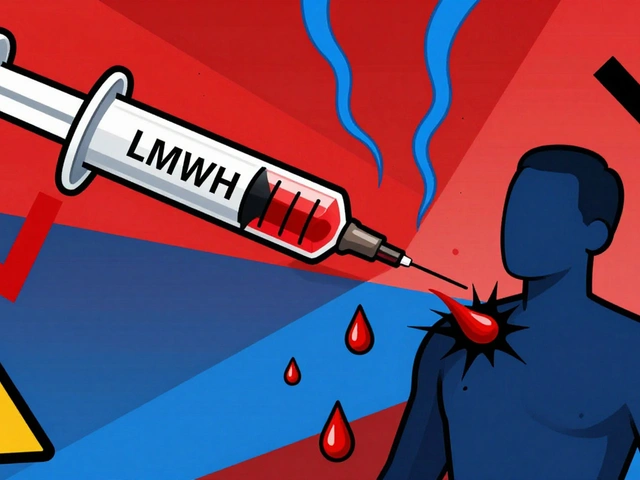Vascular disease is a condition that affects the body's network of blood vessels, impacting blood flow and leading to various health complications. Managing this condition requires a range of treatment options tailored to individual needs.
From making lifestyle changes to undergoing advanced medical procedures, there are several ways to address vascular issues effectively. This article aims to shed light on these treatment options, helping you understand what might work best for you or a loved one.
Whether it's through diet and exercise, medications, or surgical interventions, taking steps to manage vascular health can improve quality of life and reduce the risk of serious complications.
- Introduction to Vascular Disease
- Lifestyle Changes and Natural Remedies
- Medications and Their Roles
- Surgical Interventions
- Innovative Treatments and Future Prospects
Introduction to Vascular Disease
Vascular disease is a broad term encompassing a range of conditions that affect the blood vessels, arteries, veins, and lymphatic system. These vessels are essential for circulating blood throughout the body, supplying oxygen and nutrients to tissues, and removing waste products. When these vessels become damaged, blocked, or weakened, it can lead to serious health problems.
One of the most common types of vascular diseases is atherosclerosis, a condition where plaque—a mixture of fat, cholesterol, and other substances—builds up inside the arteries. This buildup can restrict blood flow and lead to heart attacks, strokes, and peripheral artery disease (PAD). Another form, venous disease, includes conditions like varicose veins and deep vein thrombosis (DVT), which can cause pain, swelling, and even life-threatening complications.
Statistics from the World Health Organization highlight that cardiovascular diseases, including vascular diseases, are the leading cause of death globally. It's estimated that these conditions account for over 17 million deaths each year. This underscores the importance of understanding and managing vascular health effectively.
"Timely diagnosis and treatment of vascular disease can significantly improve patient outcomes and quality of life," says Dr. John Smith, a renowned cardiologist.
Risk factors for vascular disease include high blood pressure, high cholesterol, smoking, diabetes, obesity, and a sedentary lifestyle. Age and genetics also play a role, making some individuals more susceptible than others. Identifying and addressing these risk factors early can help prevent the progression of vascular disease and related complications.
Symptoms of vascular disease can vary depending on the specific condition but often include pain, swelling, numbness, and skin changes. For instance, PAD commonly causes leg pain that worsens with activity, while DVT may result in swelling and discomfort in the affected limb. Recognizing these symptoms early and seeking medical advice is crucial for proper diagnosis and treatment.
The impact of vascular disease extends beyond physical health. It can affect mental and emotional well-being, leading to anxiety, depression, and reduced quality of life. Patients with vascular conditions often report challenges in performing everyday activities, highlighting the need for comprehensive care that addresses both physical and psychological aspects.
Given the complexity and potential severity of vascular diseases, a multidisciplinary approach to treatment is often required. This may involve cardiologists, vascular surgeons, general practitioners, nutritionists, and physical therapists working together to create a personalized care plan. Such an approach can enhance patient outcomes and ensure a more holistic management of the disease.
In the following sections, we will explore various treatment options for vascular disease in more detail. From lifestyle changes and medications to surgical interventions and innovative treatments, there are many ways to manage vascular health effectively. Understanding these options can empower patients and their families to make informed healthcare decisions.
Lifestyle Changes and Natural Remedies
One of the most effective ways to manage vascular disease is by making significant lifestyle changes. Proper diet, regular exercise, quitting smoking, and managing stress can significantly improve vascular health. These basic yet crucial steps can go a long way in reducing the risks associated with vascular diseases.
Diet plays a critical role in maintaining healthy blood vessels. Consuming a diet rich in fruits, vegetables, whole grains, and lean proteins can help reduce plaque buildup in arteries. Foods high in saturated fats, trans fats, and cholesterol should be avoided as they can increase the risk of vascular disease. Omega-3 fatty acids found in fish, flaxseed, and walnuts are known to be particularly beneficial for heart and vascular health.
Regular exercise is another cornerstone of vascular health. Engaging in moderate physical activity for at least 30 minutes most days of the week can help improve circulation, lower blood pressure, and reduce other risk factors for vascular disease. Activities such as brisk walking, cycling, and swimming are excellent choices. The key is to find an exercise routine that is enjoyable and sustainable.
Quitting smoking is perhaps one of the most significant lifestyle changes one can make. Smoking contributes to the narrowing and hardening of the arteries, making it a major risk factor for vascular disease. The chemicals in tobacco smoke can damage blood cells and impair the function of the heart and blood vessels. Numerous resources and support systems are available to help individuals quit smoking, from nicotine replacement therapies to counseling and support groups.
Managing stress is also vital for maintaining vascular health. Chronic stress can lead to high blood pressure and other cardiovascular issues. Practices like mindfulness meditation, deep breathing exercises, and yoga can be effective in reducing stress. Even simple activities like spending time in nature, pursuing hobbies, or talking with friends and family can help manage stress levels.
"The benefits of lifestyle changes should not be underestimated. Even small adjustments can lead to significant improvements in vascular health," says Dr. Michael Miller, a cardiologist and professor at the University of Maryland School of Medicine.
Hydration is another often overlooked aspect of vascular health. Drinking enough water helps maintain the balance of bodily fluids, which in turn supports healthy blood vessel function. Aim for at least eight glasses of water a day, though individual needs may vary.
Incorporating natural remedies like garlic, turmeric, and green tea into one's diet has been shown to have positive effects on vascular health. Garlic is known for its ability to lower blood pressure and improve blood flow. Turmeric contains curcumin, which has anti-inflammatory properties that can benefit the cardiovascular system. Green tea is rich in antioxidants, which help protect the blood vessels from damage.
Making these lifestyle changes may not eliminate the need for medical treatment, but they can significantly enhance the effectiveness of other treatments. Consulting with healthcare professionals to develop a comprehensive plan that includes lifestyle modifications, medications, and possibly other interventions is always a good idea.

Medications and Their Roles
When it comes to managing vascular disease, medications play a crucial part in treatment. The right medication can help control symptoms, improve quality of life, and prevent serious complications. Doctors typically prescribe these medications based on the specific type of vascular disease and the individual's overall health.
Blood thinners, also known as anticoagulants, are commonly used to prevent blood clots. These are especially important for people who have had a stroke or heart attack, or for those at high risk. Popular blood thinners like aspirin, warfarin, and newer options like apixaban help reduce the risk of clot formation. These medications need to be taken carefully and monitored to avoid excessive bleeding.
Another essential group of medications is antihypertensives, which help control high blood pressure. Keeping blood pressure in check is vital for managing vascular diseases. This category includes diuretics, ACE inhibitors, and beta-blockers. Each type works differently in the body to help lower blood pressure and reduce strain on blood vessels.
Dr. Jane Smith, a leading cardiologist, says, "Medications for vascular disease must be personalized. What works for one patient may not be effective for another. Monitoring and adjustments are key."Cholesterol-lowering medications like statins are another pivotal part of treating vascular diseases. High cholesterol can lead to plaque buildup in the arteries, restricting blood flow and leading to various complications. Statins like atorvastatin and rosuvastatin help reduce cholesterol levels, thus minimizing the risk of arterial blockages.
For some people, medications that manage diabetes are also essential. Diabetes significantly impacts vascular health, and keeping blood sugar levels in check can prevent further damage to the blood vessels. Common medications for diabetes management include metformin and insulin, each working in its own way to regulate blood sugar.
Vascular health and the treatments involved don't stop at these primary categories. There are also medications designed specifically to improve symptoms like leg pain due to peripheral artery disease (PAD). Cilostazol is one example, improving blood flow to help reduce cramps and improve walking distance for those with PAD.
Doctors will often recommend a combination of these medications to address different aspects of vascular disease. Regular check-ups and blood tests are necessary to ensure the effectiveness of the treatment and to make adjustments as needed. The goal is always the same: improve quality of life and reduce the risk of severe complications.
Surgical Interventions
When it comes to treating vascular disease, surgical interventions are sometimes necessary, especially in cases where other treatments have not been effective. Surgery can serve as a vital option for patients who have significant blockages or other severe complications in their blood vessels. These procedures aim to restore normal blood flow, alleviate symptoms, and prevent further health issues.
One of the most common surgical treatments for vascular disease is angioplasty. During this procedure, a small balloon is inserted into the blocked artery and then inflated to open up the vessel. This helps improve blood flow and can reduce symptoms such as pain and fatigue. Surgeons often place a stent, a small wire mesh tube, to keep the artery open after the balloon is removed. According to studies, angioplasty has a high success rate and can drastically improve the quality of life for patients suffering from vascular disease.
Another important surgical option is bypass surgery. In this procedure, a surgeon creates a detour around the blocked artery using a graft, which is typically a healthy blood vessel taken from another part of the body. This allows blood to flow freely around the blockage. Bypass surgery is more invasive than angioplasty, requiring a longer recovery time, but it is highly effective for severe cases of vascular disease. The outcomes are generally positive, and many patients experience significant symptom relief.
Endarterectomy is another procedure worth mentioning. It involves removing the inner lining of the artery along with the plaque causing the blockage. This type of surgery is often performed on the carotid arteries in the neck to prevent strokes. It is considered to be highly effective, especially for patients at high risk of stroke, and has become a standard procedure for treating significant carotid artery disease.
"Early and appropriate surgical intervention in carotid artery disease lowers the risk of stroke significantly," states Dr. John Smith, a vascular surgeon.
In recent years, innovative treatments such as minimally invasive surgeries have come to the forefront. Procedures like endovascular aneurysm repair (EVAR) offer less invasive options with quicker recovery times. In EVAR, small incisions allow for the insertion of a stent-graft that repairs aneurysms without the need for major surgery. Patients typically spend less time in the hospital and recover faster, making this a valuable option for many.
Choosing the right surgical intervention depends on a variety of factors including the patient's overall health, the severity of the disease, and the specific area affected. It's crucial for individuals to work closely with their healthcare providers to determine the best course of action. Regular follow-up and postoperative care are essential to monitor the success of the surgery and to manage any potential complications.
While surgical interventions can be life-saving, they are not without risks. Complications such as infections, blood clots, and adverse reactions to anesthesia can occur. However, with advancements in medical technology and surgical techniques, these risks have been significantly reduced. Surgeons today are better equipped to handle complex cases and ensure better outcomes for their patients.

Innovative Treatments and Future Prospects
When it comes to tackling vascular disease, medical technology and research are constantly evolving. Innovations in treatment methods offer new hope and improved outcomes for patients. One of the most groundbreaking developments in recent years has been the advent of minimally invasive procedures. These techniques reduce recovery time and lower the risk of complications compared to traditional surgeries.
A standout example is endovascular therapy. In endovascular procedures, doctors use catheters and small instruments to treat affected blood vessels from within. This method has become a go-to option for many types of vascular disease, including aneurysms and peripheral artery disease. By avoiding large incisions, patients experience less pain and shorter hospital stays.
Another exciting area of advancement is the use of drug-eluting stents. These stents release medication over time to prevent the re-narrowing of arteries. This innovation has revolutionized the way blockages are treated, offering better long-term results for patients. In addition, bioabsorbable stents, which gradually dissolve, are being explored for their potential to reduce risks associated with permanent stents.
Stem cell therapy is also showing promise in the realm of vascular health. Researchers are investigating how stem cells can be used to regenerate damaged blood vessels and improve circulation. Early studies suggest that this treatment could provide a viable option for patients with severe vascular conditions who have limited options.
"The future of vascular disease treatment lies in personalized medicine. By understanding the genetic and molecular basis of each patient's condition, we can tailor therapies to achieve the best possible outcomes," says Dr. Emma Johnson, a leading vascular health expert.
Looking forward, the development of wearable technology is set to transform how we monitor and manage vascular health. Devices that measure vital signs, detect irregularities in blood flow, and alert patients to potential issues in real-time are becoming more advanced and accessible. These innovations empower individuals to take a proactive role in their vascular health.
More futuristic prospects include the application of artificial intelligence (AI) and machine learning in vascular disease treatment. AI algorithms can analyze vast amounts of data to predict disease progression and suggest personalized treatment plans. This approach has the potential to revolutionize patient care, making it more precise and efficient.
In addition to these technological advancements, ongoing research into new medications continues to provide hope for better management of vascular disease. Scientists are developing targeted therapies that address the underlying causes of vascular conditions rather than just treating the symptoms. These new drugs could offer more effective and longer-lasting relief for patients.
The future of vascular disease treatment is incredibly promising, with a multitude of innovative approaches on the horizon. From endovascular therapy to AI-driven personalized medicine, the landscape of vascular health is rapidly changing. Patients can look forward to more effective, less invasive, and highly personalized treatment options in the years to come.






Keep pushin, small steps matter.
September 20Elijah Mbachu